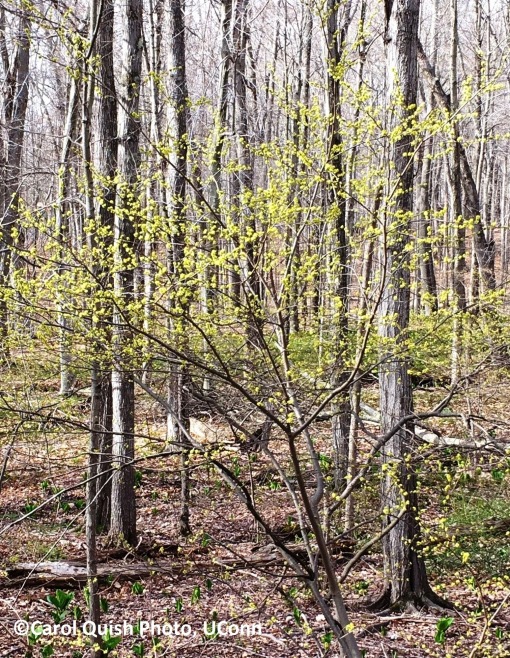
The earth is continuing to awake this week, wide-eyed and full of vigor. The most obvious, in-your-face sign is the bright and intense yellow flowers of forsythia popping up and out of landscapes and yards. There is nothing subtle about forsythia. It is loud and screaming to be seen. A designing friend once called it the “spring vomit defiling the landscape.” Another bit of sage wisdom on color theory about yellow was offered from a quilt teacher, “A little yellow goes a long way.” But I think forsythia’s splash is just what is needed after months of grey and browns of winter, especially a winter without the white of snow cover. Forsythia shocks us out of the winter doldrums and seems to waken all the other flowers.

Forsythias bloom on wood grown in the previous year. Prune forsythia the spring immediately after flowering. Flower buds develop during the summer and fall, and fall, winter or early spring pruning will remove them. Forsythia is a non-native plant here. Most species are from Asia with one originating in Southeastern Europe. Forsythia is often used a marker and reminder to apply crabgrass preventer. Once the forsythia is starting to drop its flowers, the timing is right to apply pre-emergent fertilizer. The same ground temperatures at that stage of blooming are the same ground temperatures to initiate crabgrass seed germination. Good to know.
Daffodils complement the landscape, drawing eyes away from possible blinding by overplanted forsythia hedges. Daffodils come in varying shades of yellow from soft, pale yellows and whites to deep, yellows with almost orange trumpets. Bulbs planted in clumps look more natural than soldier straight rows, although rows add a sense of formality and satisfy the orderly type of gardeners. All parts of the daffodil plant is toxic to animals, making is a good choice where deer and voles are common to visit.

Directly following the forsythia flowers, several showy trees begin blooming. First is the star magnolia, (Magnolia stellata), with its white star-like flowers. Any winds will move the tepals, and if you squint hard enough, look like twinkling stars. Star magnolia is native to Japan and is a common specimen tree here in the U.S.. Flowers delicate often succumb to frost damage and turning brown tinged.
Saucer magnolia (Magnolia x soulangiana), blooms a week or two later than the star magnolia. Saucer magnolia flowers are cup shaped in various shades of pink depending on variety. The parents of this hybrid are Magnolia denudate x Magnolia liliiflorsa, both native to China. I love the smooth grey bark visible during the winter once the leaves drop, providing great winter interest.
Another softer and less yellow flowering shrub blooming currently is Cornell pink azalea AKA Korean azalea, (Rhododendron mucronulatum). Blossoms come out before the leaves turning the multi-stemmed shrub into a mass of many clear pink flowers. It is native to Korea, Russia, Mongolia and Northern China. Bees especially appreciate its rich nectar source and often are can be seen visiting at all times of day.

Spicebush, (Lindera benzoin), is a native understory shrub with subtle, pale yellow flowers attached along branches before leaves emerge. Look into the woods to see a bit of dotted yellow haze in wet areas. Leaves can be used to make a tea. Red berries will be produced later in the season providing food for wildlife and birds.

Cornelian cherry, (Cornus mas), is not a cherry at all, it is in the dogwood family. Native to Europe where the fruits produced later in the season are used for preserves and syrups, if you can beat the birds to harvest them. Mature trees develop interesting, exfoliating bark.
Look lower to the ground for first spring flowers. The native bluets (Houstonia caerulea) are beginning their show up. Other common names are Azure Bluet and Quaker Ladies. Find them growing in moist areas near stream banks, rivers and ponds. I see them in natural lawns where no herbicides or weed and feed products were ever used. Cow fields are usually loaded with them in rural areas.

Bloodroot (Sanguinaria canadensis) is another native spring flowering plant poking its white blossoms up from the soil with its leaves following below. Flowers are self-pollinating, and then form a seed pod which ripens around July. Ants are important allies in spreading the seeds, and eating the rich lipid coating on the seeds, aiding in germination. Bloodroot occurs natural in woodland settings, blooming before the tree leaf canopy develops. Bloodroot gets its name from the red juice emitted from rhizomes historically used to dye wool and fabrics. It was also used for medicinal properties in the past.
-by Carol Quish







